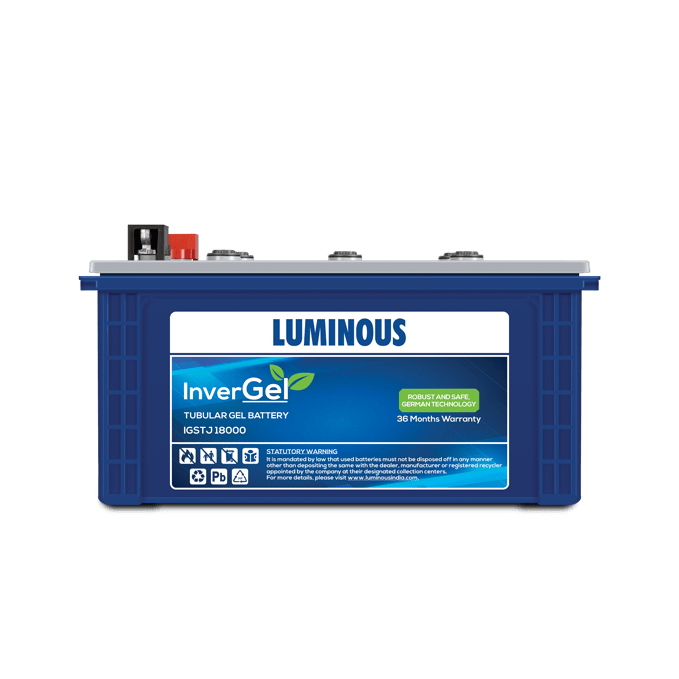
Power Solution

Inverter batteries play a crucial role in ensuring uninterrupted power supply during electrical outages. To maximise the performance and lifespan of these batteries, it's essential to maintain proper water for inverter battery. In this comprehensive guide, we will explore the importance of water for inverter batteries, the correct procedure for filling water, and the essential contents of battery water.
Understanding the Significance of Water for Inverter Battery
Inverter batteries are typically lead-acid batteries, consisting of lead dioxide (positive plate), sponge lead (negative plate), and sulfuric acid (electrolyte). The electrolyte, a mixture of water and sulfuric acid, facilitates the electrochemical reactions that produce electrical energy.
Water is a vital component of the electrolyte, and maintaining the correct water level is crucial for optimal battery performance. Insufficient water for inverter battery levels can lead to sulfation, a process where lead sulphate crystals form on the battery plates, reducing its efficiency and lifespan. On the other hand, excess water can dilute the electrolyte, affecting the battery's overall performance.
Step-by-Step Guide on How to Fill Water in Inverter Battery
● Safety First: Ensuring safety is paramount in every step of the process when filling water in your inverter battery. Before commencing the task, adhere to stringent safety measures. Turn off the inverter, disconnect it from the power source, and equip yourself with the requisite safety gear, such as gloves and safety glasses, to prevent any mishaps.
● Choose the Right Water: When it comes to the choice of water for your inverter battery, opt for distilled or demineralised water. Tap water for inverter battery might contain impurities and minerals that could have adverse effects on the battery's overall performance. Therefore, prioritise the use of water with low mineral content to enhance the longevity and efficiency of your battery.
● Check Water Levels: Conduct a thorough inspection of the water levels within each cell by opening the battery vent caps. Ensure that the water level falls above the minimum mark but stays below the maximum mark. This meticulous check is crucial for the proper functioning of the battery.
● Top-Up with Water: If the water level is below the designated minimum mark, proceed to top up each cell with distilled water using a funnel. Take your time during this step to prevent overfilling, which could potentially compromise the battery's performance.
● Use a Flashlight if Needed: In instances where the water levels are challenging to discern, use a flashlight to illuminate the cells for a clearer assessment. This additional measure ensures accuracy in evaluating the water levels within the battery.
● Wait for Absorption: Upon adding water for inverter battery, exercise patience and allow the electrolyte sufficient time to absorb the water evenly. This waiting period is crucial for the uniform distribution of water within the battery, contributing to its optimal performance.
● Recheck and Seal: Following the absorption phase, reevaluate the water levels and make any necessary adjustments. Once satisfied with the levels, securely seal the battery vent caps to prevent evaporation and maintain the integrity of the battery.
● Clean Excess Spillage: In the event of any spilt water, promptly clean it using a cloth. Addressing excess water around the battery is essential to prevent corrosion, ultimately preserving the battery's lifespan. By adhering to these comprehensive steps, you ensure the longevity and efficiency of your inverter battery.
Essential Contents of Water for Inverter Battery
● Purity: One of the fundamental aspects of optimal battery performance revolves around the purity of the battery water. It is imperative that the water used is free from any impurities, as the presence of minerals and contaminants can significantly impact the chemical reactions occurring within the battery system.
● Distilled vs. Tap Water: The choice between distilled and tap water plays a crucial role in maintaining the efficiency of inverter batteries. Distilled water stands out as the preferred option due to its high level of purity. In contrast, tap water often harbours minerals and impurities that have the potential to contribute to the formation of lead sulphate crystals on the battery plates, compromising the overall functionality of the battery.
● pH Levels: Monitoring and maintaining the right pH levels in battery water is paramount for prolonged battery life. The inherent nature of sulfuric acid tends to lower the pH over time, necessitating periodic checks and adjustments with distilled water to ensure the optimal operating conditions of the battery.
● Temperature: The temperature of battery water holds significance in influencing electrolyte density, which in turn affects the overall performance of the battery. It is advisable to fill the battery with water when it reaches a stable temperature, avoiding extremes of heat or cold. This precautionary measure contributes to the longevity and efficiency of the battery by ensuring that the electrolyte remains within the desired temperature range during operation.
Empowering Inverter Battery Users!
Maintaining the appropriate water for inverter battery is crucial for extending their lifespan and ensuring peak performance. By adhering to the comprehensive guide provided in this article and recognising the significance of using the correct water for inverter battery with the right constituents, you, as a Luminous user, can proactively manage the care of your inverter battery. Consistent monitoring and timely water top-ups are key practices that will greatly enhance the efficiency of your Luminous inverter battery, guaranteeing a reliable power supply when you need it most.
Source:
https://en.wikipedia.org/wiki/Sulfuric_acid